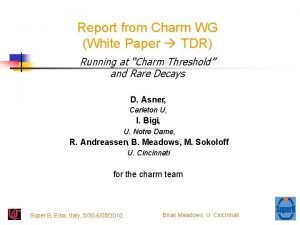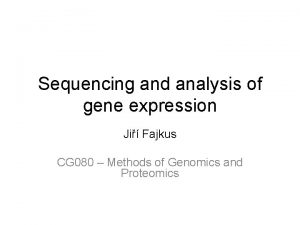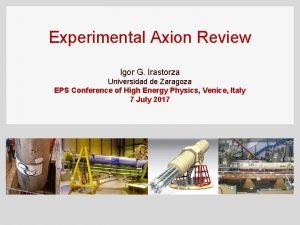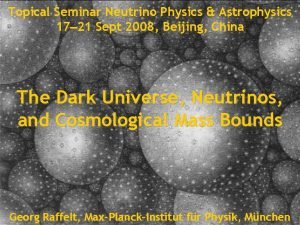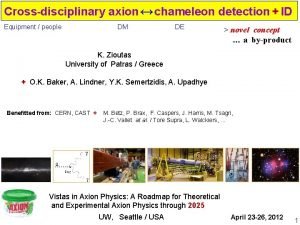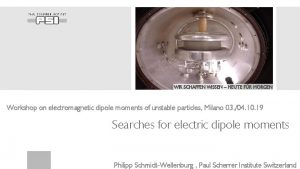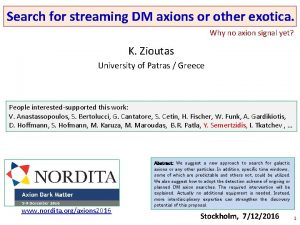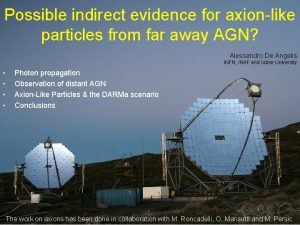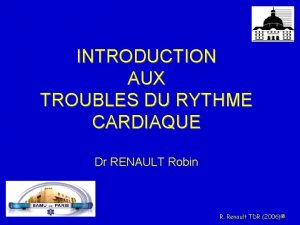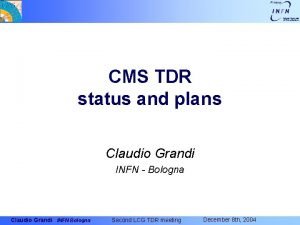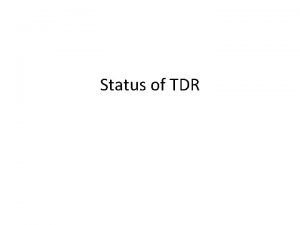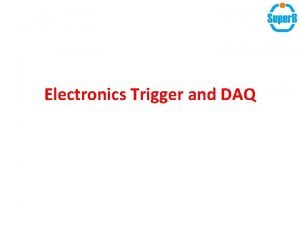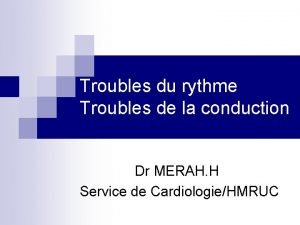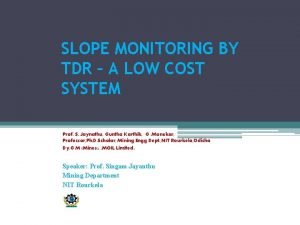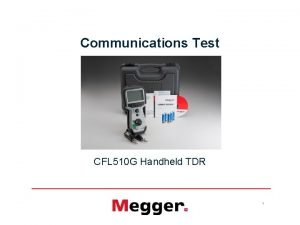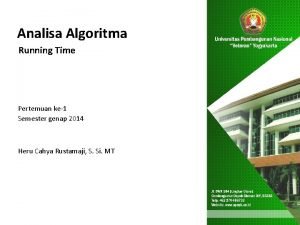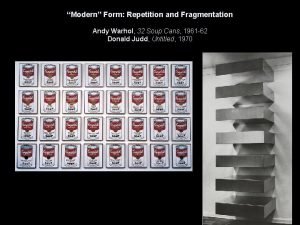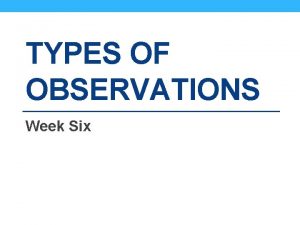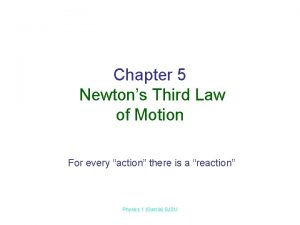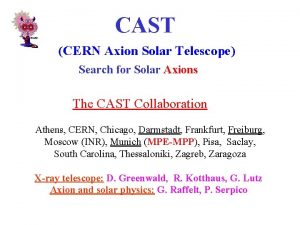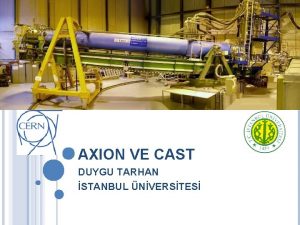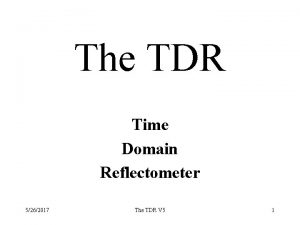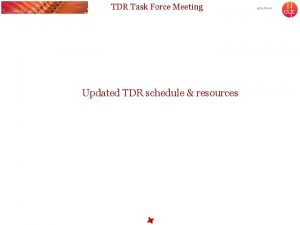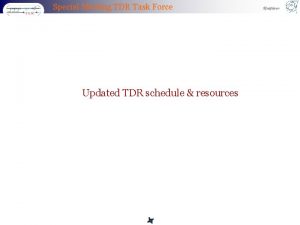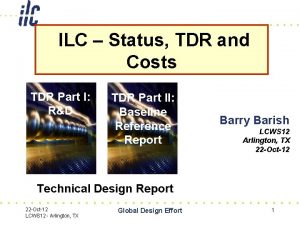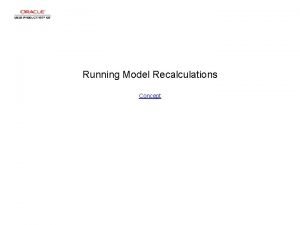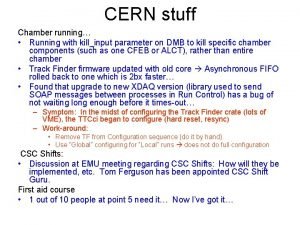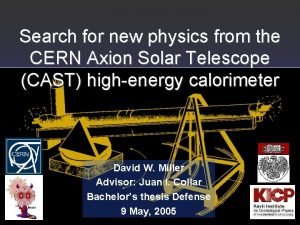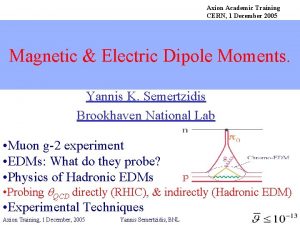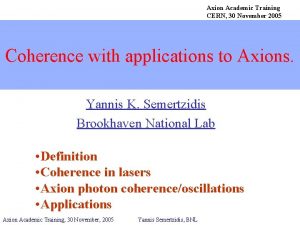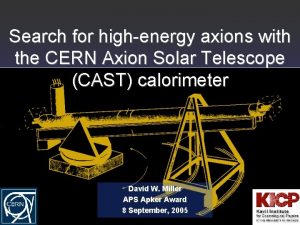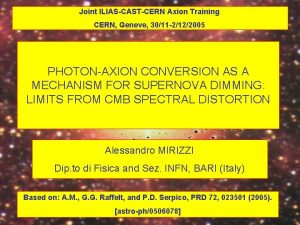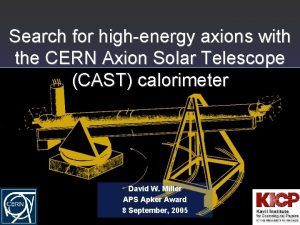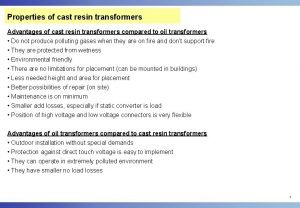The running CERN axion helioscope CAST TDR K











































![Reconstructed X-ray spectrum non-flaring Sun @ solar minimum [X] 50 -100 MK? _ Tflare Reconstructed X-ray spectrum non-flaring Sun @ solar minimum [X] 50 -100 MK? _ Tflare](https://slidetodoc.com/presentation_image_h2/8d2c32a28bea980aaf23680885b4268c/image-44.jpg)
![Reconstructed X-ray spectrum non-flaring Sun @ solar minimum [X] 50 -100 MK? ? 1. Reconstructed X-ray spectrum non-flaring Sun @ solar minimum [X] 50 -100 MK? ? 1.](https://slidetodoc.com/presentation_image_h2/8d2c32a28bea980aaf23680885b4268c/image-45.jpg)
![Reconstructed X-ray spectrum non-flaring Sun @ solar minimum [X] 50 -100 MK? B-modified solar Reconstructed X-ray spectrum non-flaring Sun @ solar minimum [X] 50 -100 MK? B-modified solar](https://slidetodoc.com/presentation_image_h2/8d2c32a28bea980aaf23680885b4268c/image-46.jpg)
![Reconstructed X-ray spectrum non-flaring Sun @ solar minimum [X] 50 -100 MK? 1. 8 Reconstructed X-ray spectrum non-flaring Sun @ solar minimum [X] 50 -100 MK? 1. 8](https://slidetodoc.com/presentation_image_h2/8d2c32a28bea980aaf23680885b4268c/image-47.jpg)
![2005 - RHESSI SMART_1 Reconstructed X-ray spectrum non-flaring Sun @ solar minimum [X] 50 2005 - RHESSI SMART_1 Reconstructed X-ray spectrum non-flaring Sun @ solar minimum [X] 50](https://slidetodoc.com/presentation_image_h2/8d2c32a28bea980aaf23680885b4268c/image-48.jpg)


![ρ � 2 nd Law of Thermodynamics Τ ? Heat transfer hotter-to-cooler Sun [km] ρ � 2 nd Law of Thermodynamics Τ ? Heat transfer hotter-to-cooler Sun [km]](https://slidetodoc.com/presentation_image_h2/8d2c32a28bea980aaf23680885b4268c/image-51.jpg)

















![2005 - RHESSI SMART_1 Reconstructed X-ray spectrum non-flaring Sun @ solar minimum [X] Solar 2005 - RHESSI SMART_1 Reconstructed X-ray spectrum non-flaring Sun @ solar minimum [X] Solar](https://slidetodoc.com/presentation_image_h2/8d2c32a28bea980aaf23680885b4268c/image-69.jpg)
- Slides: 69

The running CERN axion helioscope CAST TDR K. Zioutas University of Patras / Greece BNL seminar 19 th October 2006

Birth of solar axion astrophysics in BNL

The CAST Collaboration + LLNL P. Sikivie + Istanbul

NATURE|VOL 434 | 14 APRIL 2005 |www. nature. com /nature |www. nature. com/nature 839 SCIENCE 308 15 APRIL 2005


Axion searches in the spotlight And others…

Axion searches in the spotlight • The interest on axions reaches also string theorists…

hep-ph/0610068, 6 Oct. 2006 hep-ph/0610213, 17 Oct 2006

Motivation?

AXION PHYSICS The QCD Lagrangian : Lpert numerous phenomenological successes of QCD. G is the gluon field-strength tensor θ-term a consequence of non-perturbative effects implies violation of CP symmetry would induce EDMs of strongly interacting particles Experimentally CP is not violated in QCD the neutron EDM dn < 10 -25 e cm θ < 10 -10 why is θ so small? the strong-CP problem the only outstanding flaw in QCD To solve the strong-CP problem, Peccei-Quinn introduced a global U(1)PQ symmetry broken at a scale f. PQ, and non-perturbative quantum effects drive θ → 0 “CP-conserving value” and also generate a mass for the axion : All the axion couplings are inversely proportional to f. PQ.

Axion Dark Matter particle candidate new physics also solar axions! http: //www. fnal. gov/directorate/Longrange/Part. Astro 1003_Talks/Bauer. pdf

Solar energy is created within the core of the Sun. Nuclear reactions: 4 p = 1α The one He is about. 7 % less massive than the 4 p. Energy generated in the Sun's core takes ~106 years to reach its surface. 700 million tons H / s are converted into He. 5 million tons of pure energy is released ~105 tons of axions / sec overlooked? http: //www. solarviews. com/eng/sun. htm

Alvaro de Rujula < 1998

The Primakoff Effect 1951 H. Primakoff Behind all present axion work × B

before CAST: BNL & Tokyo axion-Bragg @ Ge, Na. I, …

CAST P. Sikivie × B Axion - source ↓ Axion - detection ↓

Cern Axion Solar Telescope Thomas Sahner

CAST α virtual X B


μM XRT HEC CCD

2004 1 arcmin

GRID measurements: with the surveyors of CERN define pointing of the magnet + XRTelescope at ~ 100 positions cold & warm Tracking System: Calibrated and correlated with celestial coordinates Filming of the Sun: March & September alignment cross check


Solar axion spectrum Pa γ 1. 7 10 -17


2 nd X-ray optic • Measured effective area (throughput) very different than simulations • Several factors at play

2004 data analysis CCD/Telescope • Spot position well determined • Full sensitivity of telescope exploited • Counts inside the spot compatible with background level Tracking data Signal simulation • No axion signal detected

2004 result • New exclusion plot, improving 2003 result • Factor of 7 improvement beyond previous experimental searches. • It goes beyond astrophysical limit of globular clusters for coherence masses • Publication now under preparation for X ? ← PVLAS e. g. KK-axions ≠ QCD axions

bridge the gap PVLAS ↔ CAST demanding + inspiring new experiments

CAST Phase II 2005 - 2007 why? how? CAST Phase II’ 2008 -2009?

CAST phase II – principle of detection Extending the coherence to higher axion masses. . . • Coherence condition (q. L << 1) is recovered for a narrow mass range around mg Ne: number of electrons/cm 3 r: gas density (g/cm 3)

Cold Windows • New effect observed: “Dark spots” on the windows – Condensation of water from residual vacuum (outgassing) of the “warm” side – Vacuum better controlled (pumped) – Periodic bake out of windows

CONSTRAINTS • No pumping + pumping • • Fast Increase - ~13 x, in about 3 seconds, Maximum increase < 20 x, in about 200 seconds. TAOs


converted axion spectrum m=0, P=0 @ resonance E =4. 48 ke. V m=0. 001, P=0. 037; E =5. 36 ke. V off-resonance m=0. 002, P=0. 074; E =6. 69 ke. V off-resonance new a. ID

converted axion spectrum m=0. 0088, P=0. 332 (4 steps) E =6. 48 ke. V off-resonance new a. ID m=0. 0214, P=0. 83 (10 steps) E =6. 46 ke. V off-resonance

1989 K. van Bibber CAST Phase II 4, 3 He Scanning progress: etal Present progress Cosmological limit (Hannestad et al, JCAP 0507 (05) 002) ~10 mbar ~0. 340 e. V

THERMO ACOUSTIC OSCILLATIONS unpredicted • Thermoacoustic oscillations were observed with 4 He gas filling for p > 2 mbar with f=3. 7 Hz and ~6% amplitude (dp/p); Isentropic model gives 3. 5% density fluctuation (dr/r). • Phenomenon was studied and solutions designed; Damping plugs installed on the linking pipes

mimic CAST (in)direct axion-signals ?

Solar temperature distribution solar corona problem Grotrian (1939) The enigma of coronal heating represents… one of the outstanding puzzles of stellar astronomy + one of the most challenging problems in astrophysics. S. M. Jefferies, Mc. Intosh, Armstrong, Bogdan, Cacciani, Fleck, Ap. JL. 648 (10. 9. 2006)151 E R Priest, D W Longcope, J Heyvaerts, Ap. J. 624 (2005) 1057

On solving the Coronal Heating Problem ▼ “one of the most important problems in astrophysics” astrophysics “There are many different heating mechanisms operating in the corona ” J. A. Klimchuk, Solar Physics 234 (2006) 41 invited review

The mechanism that heats the solar corona remains elusive. Everything above the photosphere …would not be there at all. M. J. Aschwanden, A. I. Poland, D. M. Rabin, A. R. A. A. 39 (2001) 75 C. J. Schrijver, A. A. van Ballegooijen, Ap. J. 630 ( 2005) 552 Stellar observations + theory on stellar evolution ↛ stars might possess atmospheres … that produce X-rays. L. W. Acton, Magnetodynamic Phenomena in the Solar Atm. (1996) 3 The magnetic field plays a crucial role in heating the solar corona (this has been known for many years) the exact energy release mechanism(s) is(are) still unknown. the process by which it is converted into heat and other forms remains a nagging unsolved problem. K. Galsgaard, C. E. Parnell, A. & A. 439 (August 2005) 335 R. B. Dahlburg, J. A. Klimchuk, S. K. Antiochos, Ap. J. 622 (2005) 1191

One key issue to understand the coronal heating problem is to know: S Regnier, RC Canfield, Proc. SOHO 15 Workshop - Coronal Heating, St. Andrews, Scotland, 6 -9 September 2004, ESA SP-575 (2004) 255 how magnetic energy can be stored and then released in a solar magnetic configuration. In the axion scenario B = catalyst ⊗ ρlocal, Δt ~ ωplasma=maxion the magnetic field can transform out streaming ~axions-to-photons + vice versa + transient brightenings! CAST @ Sun
![Reconstructed Xray spectrum nonflaring Sun solar minimum X 50 100 MK Tflare Reconstructed X-ray spectrum non-flaring Sun @ solar minimum [X] 50 -100 MK? _ Tflare](https://slidetodoc.com/presentation_image_h2/8d2c32a28bea980aaf23680885b4268c/image-44.jpg)
Reconstructed X-ray spectrum non-flaring Sun @ solar minimum [X] 50 -100 MK? _ Tflare < 20 MK [X] G. Peres, S. Orlando, F. reale, R. Rosner, H. Hudson, Ap. J. 528 (2000) 537
![Reconstructed Xray spectrum nonflaring Sun solar minimum X 50 100 MK 1 Reconstructed X-ray spectrum non-flaring Sun @ solar minimum [X] 50 -100 MK? ? 1.](https://slidetodoc.com/presentation_image_h2/8d2c32a28bea980aaf23680885b4268c/image-45.jpg)
Reconstructed X-ray spectrum non-flaring Sun @ solar minimum [X] 50 -100 MK? ? 1. 8 MK [X] G. Peres, S. Orlando, F. reale, R. Rosner, H. Hudson, Ap. J. 528 (2000) 537
![Reconstructed Xray spectrum nonflaring Sun solar minimum X 50 100 MK Bmodified solar Reconstructed X-ray spectrum non-flaring Sun @ solar minimum [X] 50 -100 MK? B-modified solar](https://slidetodoc.com/presentation_image_h2/8d2c32a28bea980aaf23680885b4268c/image-46.jpg)
Reconstructed X-ray spectrum non-flaring Sun @ solar minimum [X] 50 -100 MK? B-modified solar axion spectrum? inner/outer Sun ? ? 1. 8 MK feedback to CAST, … [X] G. Peres, S. Orlando, F. reale, R. Rosner, H. Hudson, Ap. J. 528 (2000) 537
![Reconstructed Xray spectrum nonflaring Sun solar minimum X 50 100 MK 1 8 Reconstructed X-ray spectrum non-flaring Sun @ solar minimum [X] 50 -100 MK? 1. 8](https://slidetodoc.com/presentation_image_h2/8d2c32a28bea980aaf23680885b4268c/image-47.jpg)
Reconstructed X-ray spectrum non-flaring Sun @ solar minimum [X] 50 -100 MK? 1. 8 MK KK-axion model generic gaγγ≈10 -13 Ge. V-1 m. KK≈10 -3 e. V L. Di. Lella, K. Z. , Astropart. Phys. 19 (2003) 145 [X] G. Peres, S. Orlando, F. reale, R. Rosner, H. Hudson, Ap. J. 528 (2000) 537
![2005 RHESSI SMART1 Reconstructed Xray spectrum nonflaring Sun solar minimum X 50 2005 - RHESSI SMART_1 Reconstructed X-ray spectrum non-flaring Sun @ solar minimum [X] 50](https://slidetodoc.com/presentation_image_h2/8d2c32a28bea980aaf23680885b4268c/image-48.jpg)
2005 - RHESSI SMART_1 Reconstructed X-ray spectrum non-flaring Sun @ solar minimum [X] 50 -100 MK? KK-axion model 1. 8 MK generic La ≈0. 16 Lsolar ≈ 106 t/s Ltrapped ≈ 200 kg/s 1022 g now gaγγ≈10 -13 Ge. V-1 m. KK≈10 -3 e. V L. Di. Lella, K. Z. , Astropart. Phys. 19 (2003) 145 [X] G. Peres, S. Orlando, F. reale, R. Rosner, H. Hudson, Ap. J. 528 (2000) 537

OFFPOINTING: 1992 YOHKOH 2005 - RHESSI 33 days

2006 Values in 3 -12 ke. V correlate with GOES implying signal? How is this energetic e- population created in the Quiet Corona ? more offpointing 2006 thru 2007 http: //sprg. ssl. berkeley. edu/~hannah/presentations/pdf_spd_06. pdf not ≠ reconstructed solar X-ray spectrum see Di. Lella + Z. (2003)
![ρ 2 nd Law of Thermodynamics Τ Heat transfer hottertocooler Sun km ρ � 2 nd Law of Thermodynamics Τ ? Heat transfer hotter-to-cooler Sun [km]](https://slidetodoc.com/presentation_image_h2/8d2c32a28bea980aaf23680885b4268c/image-51.jpg)
ρ � 2 nd Law of Thermodynamics Τ ? Heat transfer hotter-to-cooler Sun [km] ρ Suggestion: � 2 nd Law of Thermodynamics T solar X-ray self-irradiation 100 ρ 10 Earth L. Di. Lella, K. Z. , Astropart. Phys. 19 (2003) 145

The long-term evolution of AR 7978 (S 10 o) Yohkoh / SXT st 1 Lx B 1. 94±. 12 ~ filter independent Eγ < 4 ke. V RHESSI : often hard X-ray emission from non-flaring ARs. ≳ 5 ke. V Hannah, Hurford, Hudson, Abstract: 2005 AGUFMSH 11 A 0242 H AGU Fall meeting, 5 -9/12/2005 B [Gauss] <X-ray flux> / cm 2 vs. <B> July-Nov. 1996 L van Driel-Gesztelyi, P Démoulin, CH Mandrini, L Harra, JA Klimchuk, Ap. J. 586(2003)579 K. Zioutas, K. Dennerl, M. Grande, D. H. H. Hoffmann, J. Huovelin, B. Lakic, S. Orlando, A. Ortiz, Th. Papaevangelou, Y. Semertzidis, Sp. Tzamarias, O. Vilhu J. Phys. Conf. Ser. 39 (2006) 103

nd 2 Power-law index n of Lx ~ Bn = (time) YOHKOH / XRT The relation between the solar soft X-ray flux (below ~4. 4 ke. V) …and B can be approximated by a power law with an averaged index close to 2. Benevolenskaya, Kosovichev, Lemen, Scherrer, Slater Ap. J. 571 (2002) L 181 Note: axion-to-photon oscillation ∝ B 2 e. g. , in CAST DHH Hoffmann, K. Z. , Nucl. Phys. B Suppl. 151 (2006) 359 11 years solar cycle?

FLARES origin? 3 rd Lx ↑ The Electron “Problem” e- flux~105 hard X-rays from Bremsstrahlung! Bmax Rebinned peak flare X-ray intensity vs. Bmax D. Mason et al. , Ap. J. 645 (10. 7. 2006)1543 B 2 correlation G. Emslie (2005) 2005 http: //www. astro. auth. gr/%7 Evlahos/ascona/memberstalks/energetics. Emslie. ppt#366, 8

SUNSPOTS origin? relative to Photosphere (=Quiet Sun) 50% of the quiet Sun th 4 K. Zioutas, K. Dennerl, M. Grande, D. H. H. Hoffmann, J. Huovelin, B. Lakic, S. Orlando, A. Ortiz, Th. Papaevangelou, Y. Semertzidis, Sp. Tzamarias, O. Vilhu J. Phys. Conf. Ser. 39(2006)103 Plot reconstructed from : SK Solanki A. &A. Rev. 11 (2003) 153 • fundamental questions remain unanswered. • is an additional mechanism needed?

SUNSPOTS origin? relative to Photosphere (=Quiet Sun) 50% of the quiet Sun th 4 ATLAS? K. Zioutas, K. Dennerl, M. Grande, D. H. H. Hoffmann, J. Huovelin, B. Lakic, S. Orlando, A. Ortiz, Th. Papaevangelou, Y. Semertzidis, Sp. Tzamarias, O. Vilhu J. Phys. Conf. Ser. 39(2006)103 Plot reconstructed from : SK Solanki A. &A. Rev. 11 (2003) 153 • fundamental questions remain unanswered. • is an additional mechanism needed?

Conclusion CAST insists welcome . . . and beyond CAST?

Conclusion towards

Conclusion towards Every solar puzzle is due to ~axions!

Are these astrophysical ~axion signatures… …like the tip of the iceberg?


SUNSPOTS Yohkoh - XRTelescope TAUP 2005 Solar Corona Problem <1. 3 MK> quiet Sunspots = “dark spots” T ⇩ photosphere ~ 4500 K heat flux problem in umbra + penumbra Spruit, Scharmer, A. &A. (2005), astro-ph/0508504 <1. 8 MK> Umbra Corona Soft X-ray fluxes Penumbra <2. 4 MK> T ⇧ Sunspots: ~ 50 - 190 DN/s Quiet Sun: ~ 10 - 50 DN/s (ARs: ~ 500 - 4000 DN/s) sunspot plasma parameters are higher than @ quiet-Sun B ~ 2 k. G above most sunspots Temperature distributions ! A. Nindos, M. R. Kundu, S. M. White, K. Shibasaki, N. Gopalswamy, Ap. J. SUPPL. 130 (2000) 485 -------------------------------------------------------------------------------------------------------------------------------------- “… sunspots remain mysterious”. The penumbral mystery … the very reason for its existence unknown. http: //www. solarphysics. kva. se/Nature. Nov 2002/background. html

X-rays SXT S 60 o N 60 o Yohkoh SXT equator ν’s Comparison of normalized probability distribution functions formed from power spectra of data from SXT equator (red), SXT N 60 -S 60 (green), Homestake (black), and GALLEX (blue). Note that the SXT (red) and GALLEX data are equatorial, and the other two are not. Frequencies are given in cycles per year. D. O. Caldwell, P. A. Sturrock, Astroparticle Phys. 23 (2005) 543

Yohkoh X-rays SXT S 60 o N 60 o SXT equator Homestake GALLEX ν’s Comparison of normalized probability distribution functions formed from power spectra of data from SXT equator (red), SXT N 60 -S 60 (green), Homestake (black), and GALLEX (blue). Note that the SXT (red) and GALLEX data are equatorial, and the other two are not. Frequencies are given in cycles per year. D. O. Caldwell, P. A. Sturrock, Astroparticle Phys. 23 (2005) 543

Standard Solar Model problem with: Solar metallicity manifestation of 2 opposite effects?

Soft X-ray Corona ß WL K-Corona? mm photosphere Why this occurs is unclear! D. Altrock, Private communication The rotation profile across latitude for all years averaged. Short solid line: sunspot groups; thin solid line: Mt. Wilson Doppler measurements of the photosphere; dashed line: the WL K-corona. M. A. Weber, L. W. Acton, D. Alexander, S. Kubo, H. Hara, Sol. Phys. 189 ( 1999) 271

X-ray mysteries: • Class 0 protostar (10 -100 kyears) origin of X-rays (<10 ke. V): matter is falling 10 x faster? K. Hamaguchi et al. , Ap. J. 623 (2005) 291 Similar-to-Sun logic = wrong Galactic Center origin of diffuse X-rays? too hot ( ~ 90 MK) to be a gravitationally bound plasma! how to produce it? Clusters of Galaxies “strong evidence of some thing wrong” “physical mechanism for the energy (or the entropy) excess? “ “some homogeneous process heats the gas” P. Tozzi, astro-ph/0602072 [see also B. A. Reid, D. N. Spergel, astro-ph/0601133 v 2 (23. 7. 2006)] pp. 4 -6, 27, 30 XRBradiation origin?

TOTAL SOLAR IRRADIANCE visible light strong evidence that the magnetic elements with higher flux are less bright. N. A. Krivova, S. K. Solanki, M. Fligge, Y. C. Unruh, A. &A. 399 (2003) L 1
![2005 RHESSI SMART1 Reconstructed Xray spectrum nonflaring Sun solar minimum X Solar 2005 - RHESSI SMART_1 Reconstructed X-ray spectrum non-flaring Sun @ solar minimum [X] Solar](https://slidetodoc.com/presentation_image_h2/8d2c32a28bea980aaf23680885b4268c/image-69.jpg)
2005 - RHESSI SMART_1 Reconstructed X-ray spectrum non-flaring Sun @ solar minimum [X] Solar axion spectrum? 50 -100 MK? KK-axion model 1. 8 MK generic La ≈0. 16 Lsolar ≈ 106 t/s Ltrapped ≈ 200 kg/s 1022 g now gaγγ≈10 -13 Ge. V-1 m. KK≈10 -3 e. V L. Di. Lella, K. Z. , Astropart. Phys. 19 (2003) 145 [X] G. Peres, S. Orlando, F. reale, R. Rosner, H. Hudson, Ap. J. 528 (2000) 537
 In the old days there lived
In the old days there lived Running running running
Running running running Tdr running
Tdr running Dna sequencing methods
Dna sequencing methods Axion
Axion Axion particle
Axion particle Axion
Axion Axion particle
Axion particle Axion
Axion Axion particle
Axion particle Cast duplication
Cast duplication Tdr baseline
Tdr baseline Bouveret ecg
Bouveret ecg Cms tdr
Cms tdr Tdr status
Tdr status Tdr studio
Tdr studio Tdr calculation
Tdr calculation Tdr ventriculaire
Tdr ventriculaire Low cost tdr
Low cost tdr Handheld tdr
Handheld tdr Cách giải mật thư tọa độ
Cách giải mật thư tọa độ Các châu lục và đại dương trên thế giới
Các châu lục và đại dương trên thế giới Bổ thể
Bổ thể Tư thế ngồi viết
Tư thế ngồi viết Thẻ vin
Thẻ vin Thế nào là giọng cùng tên?
Thế nào là giọng cùng tên? Thể thơ truyền thống
Thể thơ truyền thống Bài hát chúa yêu trần thế alleluia
Bài hát chúa yêu trần thế alleluia Từ ngữ thể hiện lòng nhân hậu
Từ ngữ thể hiện lòng nhân hậu Khi nào hổ con có thể sống độc lập
Khi nào hổ con có thể sống độc lập Diễn thế sinh thái là
Diễn thế sinh thái là Vẽ hình chiếu vuông góc của vật thể sau
Vẽ hình chiếu vuông góc của vật thể sau Phép trừ bù
Phép trừ bù Tỉ lệ cơ thể trẻ em
Tỉ lệ cơ thể trẻ em Lời thề hippocrates
Lời thề hippocrates đại từ thay thế
đại từ thay thế Vẽ hình chiếu đứng bằng cạnh của vật thể
Vẽ hình chiếu đứng bằng cạnh của vật thể Quá trình desamine hóa có thể tạo ra
Quá trình desamine hóa có thể tạo ra Công của trọng lực
Công của trọng lực Các môn thể thao bắt đầu bằng tiếng nhảy
Các môn thể thao bắt đầu bằng tiếng nhảy Thế nào là mạng điện lắp đặt kiểu nổi
Thế nào là mạng điện lắp đặt kiểu nổi Hình ảnh bộ gõ cơ thể búng tay
Hình ảnh bộ gõ cơ thể búng tay Khi nào hổ mẹ dạy hổ con săn mồi
Khi nào hổ mẹ dạy hổ con săn mồi Dạng đột biến một nhiễm là
Dạng đột biến một nhiễm là Nguyên nhân của sự mỏi cơ sinh 8
Nguyên nhân của sự mỏi cơ sinh 8 Phản ứng thế ankan
Phản ứng thế ankan Gấu đi như thế nào
Gấu đi như thế nào Thiếu nhi thế giới liên hoan
Thiếu nhi thế giới liên hoan điện thế nghỉ
điện thế nghỉ Một số thể thơ truyền thống
Một số thể thơ truyền thống Trời xanh đây là của chúng ta thể thơ
Trời xanh đây là của chúng ta thể thơ Thế nào là hệ số cao nhất
Thế nào là hệ số cao nhất Sơ đồ cơ thể người
Sơ đồ cơ thể người Ng-html
Ng-html Số nguyên tố là
Số nguyên tố là Phối cảnh
Phối cảnh đặc điểm cơ thể của người tối cổ
đặc điểm cơ thể của người tối cổ Các châu lục và đại dương trên thế giới
Các châu lục và đại dương trên thế giới Tư thế worms-breton
Tư thế worms-breton ưu thế lai là gì
ưu thế lai là gì Tư thế ngồi viết
Tư thế ngồi viết Cái miệng nó xinh thế
Cái miệng nó xinh thế Its time to start running
Its time to start running Running time adalah
Running time adalah Girl running on a balcony
Girl running on a balcony Are we running out of ip addresses
Are we running out of ip addresses Vertical
Vertical Examples of running records of child observation
Examples of running records of child observation A ship’s compartment corresponds to a room in a building
A ship’s compartment corresponds to a room in a building Walking/running action and reaction
Walking/running action and reaction


